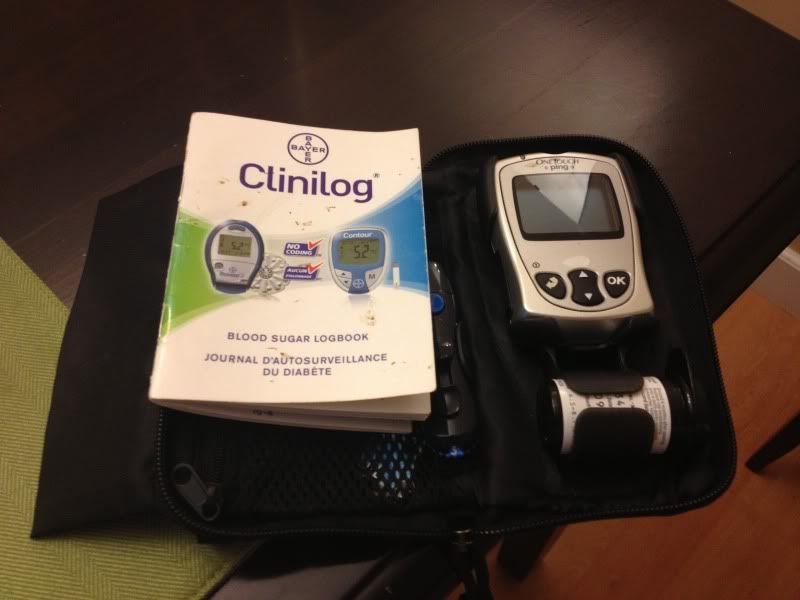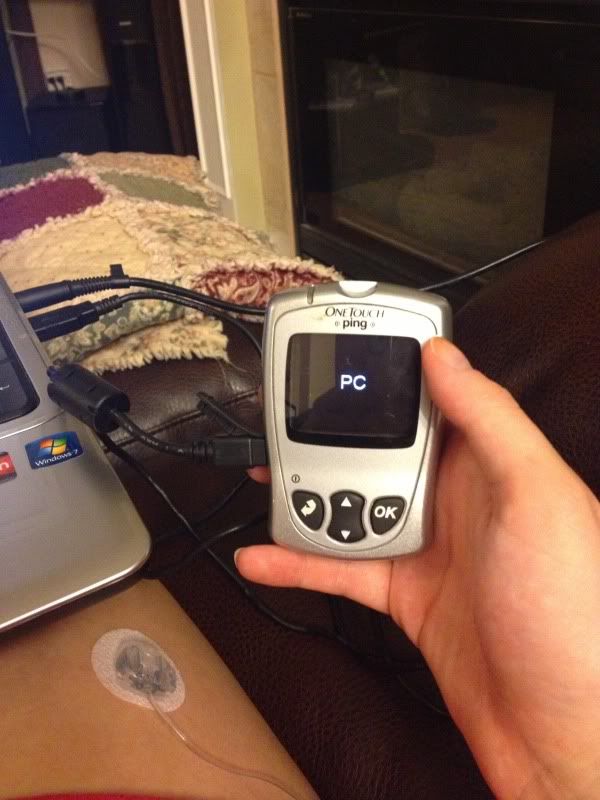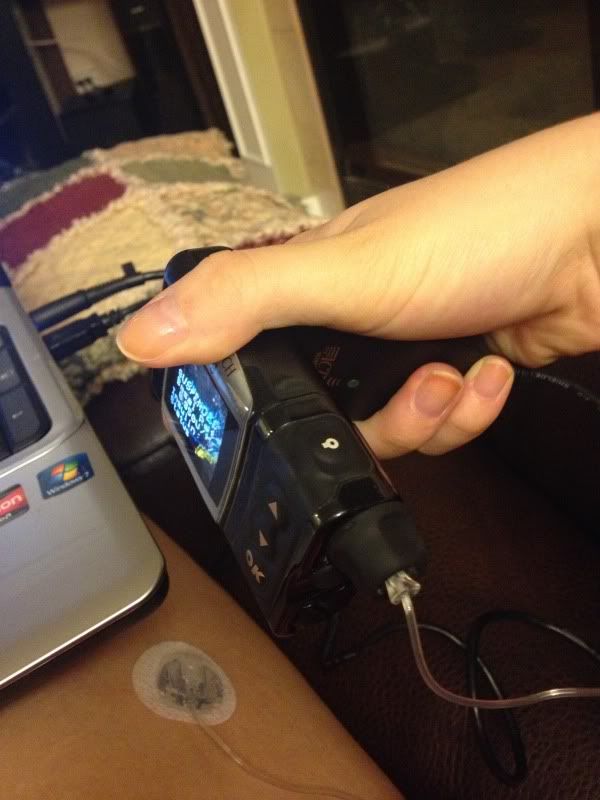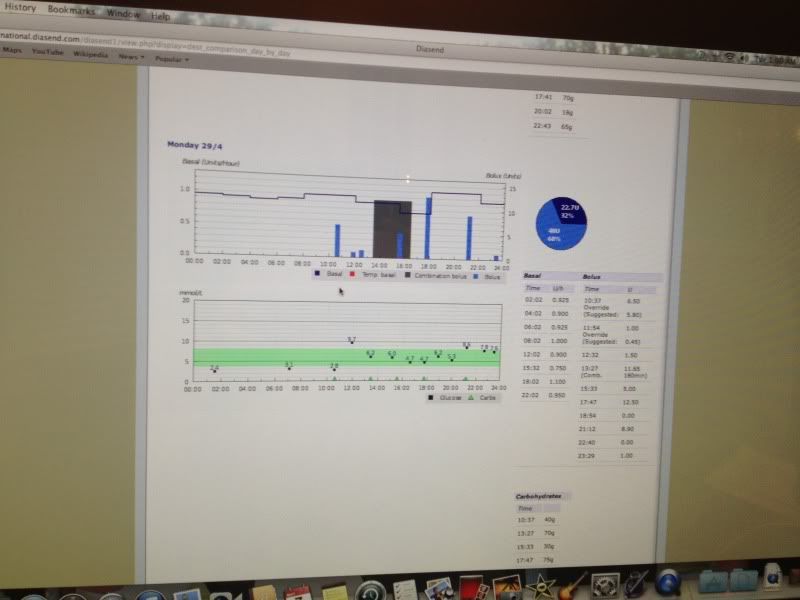I post a little update every time I blog about what's going on with my diabetes, but I have never actually posted what the 'medical' side of it looks like... I'm sure everyone knows I have more doctors appts than the average pregnancy, but what actually goes on with the diabetes side? SO - why not post about that?
Once the written part is all done and complete, I have to download everything from my pump and meter to bring with me. I think that they can download my pump at the appts, but they use the old Animas EZ something or other (which was awful) where I use the new and greatly improved website www.diasend.com. It used to literally be a 45 minute ordeal to download my pump, because the program would freeze constantly and the dongle would never work properly, but now it actually works pretty well. It's still a little time consuming, and the dongle can be very finicky - you need to hold it a certain way in order for it to download from the pump without losing the connection, but it is a HUGE improvement from before. You need to suspend (stop delivery) on the pump too, and one time I forgot to turn back on the pump for about 1.5 hours, which led to a little bit of a high afterwards, not too fun. But that was just me being stupid. Don't mind my (successful) thigh infusion site in these pics! I'm now running on my third thigh set in a row - so far so good!!
Then.... It all gets printed off. I print my pump settings, a form with all sorts of averages and whatnots, and two separate forms that show what my blood actually looked like over the past week or two. Lots of paper, haha. My file at the clinic is HUGE because they put all of these in there every time I see them. I would probably just throw them out after a few appts, but they have them alllll stored in there.
By now it's usually well after midnight (I get distracted easily so this whole process takes FOREVER) so it's off to bed. Jamie used to help by doing all of my averages, but now that I have much more free time than him, I've relieved him from that duty. At my actual appts, it always starts off with a weigh-in and then a urine test to check for protein, ketones and glucose. I've had traces of protein a couple times, and 2 weeks ago I was apparently spilling glucose into my urine, but apparently it's not a big deal and just 'happens' sometimes. Never had ketones so far, so I'm happy with that. I also test for ketones at home if I have a high that won't budge for a couple of hours. I suck at what it all actually means now, but I'm pretty sure ketones are when your body can't handle the amount of glucose in your blood and starts burning fat and other important things. I can't remember exactly though, and too lazy to google. I just know that they're bad news bears.
I meet with the nurse first, and she writes down all of my averages/ basal rates/ total daily doses, etc into my chart. We talk about where I'm having issues, and what kind of things I want to talk to the endo about. She also checks my blood pressure, which has actually been GREAT through pregnancy. I sometimes have higher blood pressure during Doctor's appts (which is pretty common), but lately it's been awesome. Hoping it stays that way. After the nurse I get shuffled back into the waiting room until it's my turn to see the dietitian. The dietitian part is usually pretty short now. It was longer before when I couldn't keep anything down, but now it's mostly just 'are you eating well?' 'yep' and again we talk about where there are some highs or lows and if it's related more to basal rates, correction factors or crappy carb counting. Because I'm on insulin (instead of just a diet based plan like with gestational diabetes) there isn't really too much to discuss as far as what I 'can' or 'can't' eat. Shuffled back into the waiting room.... Until it's time to meet with the endocrinologist (diabetes doctor). There are three (well now two, because one is on maternity leave) endos in the clinic and they all trade off weeks. Now that I'm further along, we measure my fundal height and go over mostly the forms I printed from diasend. Working together, we adjust the basal rates (how much insulin I take per hour), ISF (insulin-sensitivity factors ie: how much insulin is needed to correct a high blood sugar) and my I:C ratios (insulin to carb ratios, which is how many grams of carb it takes per unit of insulin). This is for sure the most important part of the appt, and I usually leave with a new set of things to try. Granted - it's a moving target. What worked at 23 weeks doesn't work at 24 weeks because I suddenly have more insulin resistance or whatever. It's frustrating, but all I can do is try my best and be diligent about it.
Lastly - the most important part.... Dashing out to the parking lot because my appt ran over a couple minutes and hoping I didn't get a parking ticket!!!! The appt's usually run just under an hour, so I only buy one hour of parking. The next option is a full extra hour, which just seems like a waste. I should buy impark stock, those a-holes take a lot of my money!!! I've been good at not getting tickets, but it is unbelievable how much it costs to park at the hospital. It's not like I'm parking there to go to a concert or transfer to transit or something, crazy!! Also, you have no way of knowing if your appt that is normally 50 minutes will run over for some reason.
So... That's my diabetes routine! Of course every day consists of testing 12-15 times a day, and constantly adjusting/ calculating as I go. It's a big job to be diabetic in general, and even more while pregnant! But it will ALL be worth it in the end. :)
I have appts with the 'diabetes in pregnancy' clinic at the hospital where I'll be delivering every two weeks. I've been seeing them since early 2011, when Jamie and I started seriously talking about having a baby in the future. There is a lot of preparation that goes into a diabetic pregnancy and my endo thought it was best to start the process early so I would know what to expect and make sure my health was where it should be before I got pregnant. Granted, we put off TTC so many times and it took a little while, I didn't actually end up getting pregnant until November of 2012 - when I hadn't been to the clinic in about 6 months. My A1C (or average over the past 3 months) was at 6.1 though, so things were still looking pretty good! Anyways, here's my routine!
I try to keep myself fairly organized by recording my blood sugars every few days in my small little logbook. I used to be awesome at recording ALL the time (actually recorded everything from 2009-2011 as it was happening) but now I'm pretty bad with writing stuff down as it happens. I like to keep it as current as possible though, because it helps me notice trends quickly. Step one - make sure I have everything written down in this logbook.
 |
| Don't mind the bloodstains, haha. |
Once my logbook is up to date, I transfer all of those numbers onto these wonderful charts (from the 80's) that I need to complete for the diabetes nurse. They are these giant pieces of paper that need to be folded over a bunch of times to fit in a binder, and they use terms like PC and AC (I think that's right) for before and after meals instead of just 'before breakfast' or 'after breakfast'. The charts don't really allow for enough readings, so I need to improvise and put in extra numbers where you're 'supposed' to put carbs/ insulin etc. I have never written down my carbs or insulin on these forms though, oh well. They have a spot at the bottom for averages, and I think that's the main point of the entire thing - it works for me. It would be easiest if I did these weekly, but of course I don't even pull out my binder until about 10PM the night before an appt.
 |
| Lots of writing!!! |
Once the written part is all done and complete, I have to download everything from my pump and meter to bring with me. I think that they can download my pump at the appts, but they use the old Animas EZ something or other (which was awful) where I use the new and greatly improved website www.diasend.com. It used to literally be a 45 minute ordeal to download my pump, because the program would freeze constantly and the dongle would never work properly, but now it actually works pretty well. It's still a little time consuming, and the dongle can be very finicky - you need to hold it a certain way in order for it to download from the pump without losing the connection, but it is a HUGE improvement from before. You need to suspend (stop delivery) on the pump too, and one time I forgot to turn back on the pump for about 1.5 hours, which led to a little bit of a high afterwards, not too fun. But that was just me being stupid. Don't mind my (successful) thigh infusion site in these pics! I'm now running on my third thigh set in a row - so far so good!!
Here's what the diasend site looks like as it's downloading - along with a pic of my computer background of cute little Holly before she got hairy and fat. She is long overdue for a full strip! Next week, that's my plan. :)
 |
| Cutie patootie! |
Okay, so once I have everything downloaded, I usually spend some time going over all of the results. Diasend is awesome because it can give you SO MUCH information! I am a big information person, and like to have all the numbers and stats organized in different ways and review them all. Over time, I've learned which specific reports are relevant to me (because they aren't ALL relevant of course). I am now primarily using the report in the photo below, which I love because it ALMOST looks like I have a CGMS (continuous glucose monitoring system) with how often I test my blood now. It is really great to see where I have highs or lows, and how it relates to how much insulin I am taking at the time. A couple weeks ago I noticed high numbers almost every day at a certain time, and also noticed that my insulin was decreased around that same time. It was pretty easily fixed with a correction to my basal rates! Of course it still isn't perfect, and I don't expect it to be. But I'm glad that I can at least have stats to try to help me through it all.
Then.... It all gets printed off. I print my pump settings, a form with all sorts of averages and whatnots, and two separate forms that show what my blood actually looked like over the past week or two. Lots of paper, haha. My file at the clinic is HUGE because they put all of these in there every time I see them. I would probably just throw them out after a few appts, but they have them alllll stored in there.
By now it's usually well after midnight (I get distracted easily so this whole process takes FOREVER) so it's off to bed. Jamie used to help by doing all of my averages, but now that I have much more free time than him, I've relieved him from that duty. At my actual appts, it always starts off with a weigh-in and then a urine test to check for protein, ketones and glucose. I've had traces of protein a couple times, and 2 weeks ago I was apparently spilling glucose into my urine, but apparently it's not a big deal and just 'happens' sometimes. Never had ketones so far, so I'm happy with that. I also test for ketones at home if I have a high that won't budge for a couple of hours. I suck at what it all actually means now, but I'm pretty sure ketones are when your body can't handle the amount of glucose in your blood and starts burning fat and other important things. I can't remember exactly though, and too lazy to google. I just know that they're bad news bears.
I meet with the nurse first, and she writes down all of my averages/ basal rates/ total daily doses, etc into my chart. We talk about where I'm having issues, and what kind of things I want to talk to the endo about. She also checks my blood pressure, which has actually been GREAT through pregnancy. I sometimes have higher blood pressure during Doctor's appts (which is pretty common), but lately it's been awesome. Hoping it stays that way. After the nurse I get shuffled back into the waiting room until it's my turn to see the dietitian. The dietitian part is usually pretty short now. It was longer before when I couldn't keep anything down, but now it's mostly just 'are you eating well?' 'yep' and again we talk about where there are some highs or lows and if it's related more to basal rates, correction factors or crappy carb counting. Because I'm on insulin (instead of just a diet based plan like with gestational diabetes) there isn't really too much to discuss as far as what I 'can' or 'can't' eat. Shuffled back into the waiting room.... Until it's time to meet with the endocrinologist (diabetes doctor). There are three (well now two, because one is on maternity leave) endos in the clinic and they all trade off weeks. Now that I'm further along, we measure my fundal height and go over mostly the forms I printed from diasend. Working together, we adjust the basal rates (how much insulin I take per hour), ISF (insulin-sensitivity factors ie: how much insulin is needed to correct a high blood sugar) and my I:C ratios (insulin to carb ratios, which is how many grams of carb it takes per unit of insulin). This is for sure the most important part of the appt, and I usually leave with a new set of things to try. Granted - it's a moving target. What worked at 23 weeks doesn't work at 24 weeks because I suddenly have more insulin resistance or whatever. It's frustrating, but all I can do is try my best and be diligent about it.
Lastly - the most important part.... Dashing out to the parking lot because my appt ran over a couple minutes and hoping I didn't get a parking ticket!!!! The appt's usually run just under an hour, so I only buy one hour of parking. The next option is a full extra hour, which just seems like a waste. I should buy impark stock, those a-holes take a lot of my money!!! I've been good at not getting tickets, but it is unbelievable how much it costs to park at the hospital. It's not like I'm parking there to go to a concert or transfer to transit or something, crazy!! Also, you have no way of knowing if your appt that is normally 50 minutes will run over for some reason.
So... That's my diabetes routine! Of course every day consists of testing 12-15 times a day, and constantly adjusting/ calculating as I go. It's a big job to be diabetic in general, and even more while pregnant! But it will ALL be worth it in the end. :)





No comments:
Post a Comment